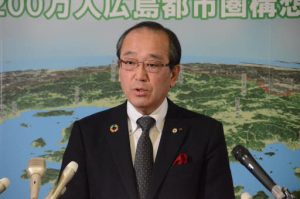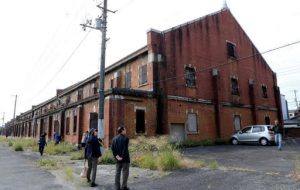Hiroshima Mayor considers drop in number of A-bombed buildings to be crisis
Dec. 19, 2019
by Junji Akechi and Koji Higuchi, Staff Writers
Hiroshima Prefecture owns the former Army Clothing Depot, the largest site with A-bombed buildings in the City of Hiroshima. In response to its draft of demolishing two buildings, and preserving the outer appearance of another, Hiroshima Mayor Kazumi Matsui requested on December 18, that all the buildings be preserved. This request was prompted by a sense of crisis over preserving the A-bombed buildings and by the activities of A-bomb survivors, who seek to maintain the preservation of the former Army Clothing Depot as a silent A-bomb victim.
In a press conference, Mr. Matsui again mentioned the significance of preserving the A-bombed buildings, saying, “When all the A-bomb survivors have passed away in the future, the A-bombed buildings will remain as a starting point to convey the story of the atomic bombing.”
The city government began to register A-bombed buildings on the City of Hiroshima’s list of A-bombed buildings, and to provide financial assistance for costs involving the preservation of the privately owned A-bombed buildings, in fiscal year 1993. It registered 86 buildings on the City of Hiroshima’s list of A-bombed buildings, including privately owned ones, in addition to the Atomic Bomb Dome, located in Naka Ward. The registration number has been declining from 98 since the end of fiscal year 1996, the peak year, as the A-bombed buildings have deteriorated with age.
The national government and the Hiroshima prefectural government that own buildings at the former Army Clothing Depot and the Hiroshima city government have conducted working-level study sessions about the preservation and use of the four buildings since fiscal year 2016. The city government, which listened to the draft from the prefectural government in the session held at the end of November in 2019, shared its idea of preserving all the buildings with the national and prefectural governments. A senior official of the city government said with emphasis, “We even ask those in the private sector who own A-bombed buildings to preserve them, to say nothing of the former Army Clothing Depot, public property. There is room for further consideration.”
The prefectural government is discussing preserving the outer appearance of building No.1 and demolishing buildings No. 2 and No. 3, considering embarking on the project in fiscal year 2020. Hiroshima Governor Hidehiko Yuzaki mentioned the idea of making a final decision, based on the opinions of people in Hiroshima Prefecture and the necessity of taking prompt steps to ensure the safety of these buildings. Hiroshima City has now requested the prefecture to deal with the issue more carefully.
Iwao Nakanishi, 89, a resident of the City of Kure, experienced the atomic bombing within the grounds of the Army Clothing Depot and helped care for the wounded that were carried in. He has repeatedly shared his A-bomb experience there. He said, “It is very encouraging that the city government has clearly expressed the preservation of all the buildings. Taking this opportunity, I hope the national and prefectural governments, and the city government, will work together and seriously think about how to revive the buildings.”
Groups of A-bomb survivors also spoke out, one after another, and evaluated the request of the city government. Kunihiko Sakuma, 75, chair of the Hiroshima Prefectural Confederation of A-bomb Sufferers Organizations (Hiroshima Prefectural Hidankyo), said, “The buildings at the Army Clothing Depot are important buildings that convey an aspect of Hiroshima as a military city, including their size.” Toshiyuki Mimaki, 77, the acting chair of the other Hiroshima Prefectural Hidankyo, chaired by Sunao Tsuboi, said, “Each person in Hiroshima Prefecture is required to be prepare for continued preservation, and to not force it only on the prefectural government.”
The former Army Clothing Depot, whose iron doors were warped by the A-bomb blast, illustrates the intensity of the atomic bombing. The Poet Sankichi Toge wrote of a disastrous scene at a first-aid station in his poem titled Soko no Kiroku (Records of the Warehouse). Masahiko Ikeda, 73, the secretary general of the Association of Preservation Data on Hiroshima Literature, said, “The cultural value of the former Army Clothing Depot is high.” This is also a place where the late Goro Shikoku, an antiwar painter who called for peace, worked before he was drafted. Mr. Ikeda proposed that works of these two people be displayed at the Depot and said, “The city government should not consider it to be a foregone conclusion that buildings will be demolished, and I hope it will consider how to use the buildings in a responsible way.” Discussions from various viewpoints are necessary to lead to a conclusion that satisfies A-bomb survivors and citizens.
(Originally published on December 19, 2019)
Hiroshima Prefecture owns the former Army Clothing Depot, the largest site with A-bombed buildings in the City of Hiroshima. In response to its draft of demolishing two buildings, and preserving the outer appearance of another, Hiroshima Mayor Kazumi Matsui requested on December 18, that all the buildings be preserved. This request was prompted by a sense of crisis over preserving the A-bombed buildings and by the activities of A-bomb survivors, who seek to maintain the preservation of the former Army Clothing Depot as a silent A-bomb victim.
In a press conference, Mr. Matsui again mentioned the significance of preserving the A-bombed buildings, saying, “When all the A-bomb survivors have passed away in the future, the A-bombed buildings will remain as a starting point to convey the story of the atomic bombing.”
The city government began to register A-bombed buildings on the City of Hiroshima’s list of A-bombed buildings, and to provide financial assistance for costs involving the preservation of the privately owned A-bombed buildings, in fiscal year 1993. It registered 86 buildings on the City of Hiroshima’s list of A-bombed buildings, including privately owned ones, in addition to the Atomic Bomb Dome, located in Naka Ward. The registration number has been declining from 98 since the end of fiscal year 1996, the peak year, as the A-bombed buildings have deteriorated with age.
The national government and the Hiroshima prefectural government that own buildings at the former Army Clothing Depot and the Hiroshima city government have conducted working-level study sessions about the preservation and use of the four buildings since fiscal year 2016. The city government, which listened to the draft from the prefectural government in the session held at the end of November in 2019, shared its idea of preserving all the buildings with the national and prefectural governments. A senior official of the city government said with emphasis, “We even ask those in the private sector who own A-bombed buildings to preserve them, to say nothing of the former Army Clothing Depot, public property. There is room for further consideration.”
The prefectural government is discussing preserving the outer appearance of building No.1 and demolishing buildings No. 2 and No. 3, considering embarking on the project in fiscal year 2020. Hiroshima Governor Hidehiko Yuzaki mentioned the idea of making a final decision, based on the opinions of people in Hiroshima Prefecture and the necessity of taking prompt steps to ensure the safety of these buildings. Hiroshima City has now requested the prefecture to deal with the issue more carefully.
Iwao Nakanishi, 89, a resident of the City of Kure, experienced the atomic bombing within the grounds of the Army Clothing Depot and helped care for the wounded that were carried in. He has repeatedly shared his A-bomb experience there. He said, “It is very encouraging that the city government has clearly expressed the preservation of all the buildings. Taking this opportunity, I hope the national and prefectural governments, and the city government, will work together and seriously think about how to revive the buildings.”
Groups of A-bomb survivors also spoke out, one after another, and evaluated the request of the city government. Kunihiko Sakuma, 75, chair of the Hiroshima Prefectural Confederation of A-bomb Sufferers Organizations (Hiroshima Prefectural Hidankyo), said, “The buildings at the Army Clothing Depot are important buildings that convey an aspect of Hiroshima as a military city, including their size.” Toshiyuki Mimaki, 77, the acting chair of the other Hiroshima Prefectural Hidankyo, chaired by Sunao Tsuboi, said, “Each person in Hiroshima Prefecture is required to be prepare for continued preservation, and to not force it only on the prefectural government.”
The former Army Clothing Depot, whose iron doors were warped by the A-bomb blast, illustrates the intensity of the atomic bombing. The Poet Sankichi Toge wrote of a disastrous scene at a first-aid station in his poem titled Soko no Kiroku (Records of the Warehouse). Masahiko Ikeda, 73, the secretary general of the Association of Preservation Data on Hiroshima Literature, said, “The cultural value of the former Army Clothing Depot is high.” This is also a place where the late Goro Shikoku, an antiwar painter who called for peace, worked before he was drafted. Mr. Ikeda proposed that works of these two people be displayed at the Depot and said, “The city government should not consider it to be a foregone conclusion that buildings will be demolished, and I hope it will consider how to use the buildings in a responsible way.” Discussions from various viewpoints are necessary to lead to a conclusion that satisfies A-bomb survivors and citizens.
(Originally published on December 19, 2019)









